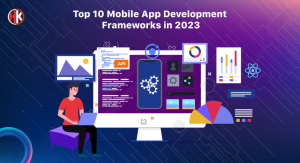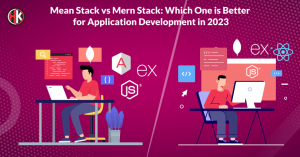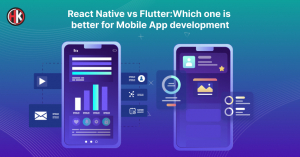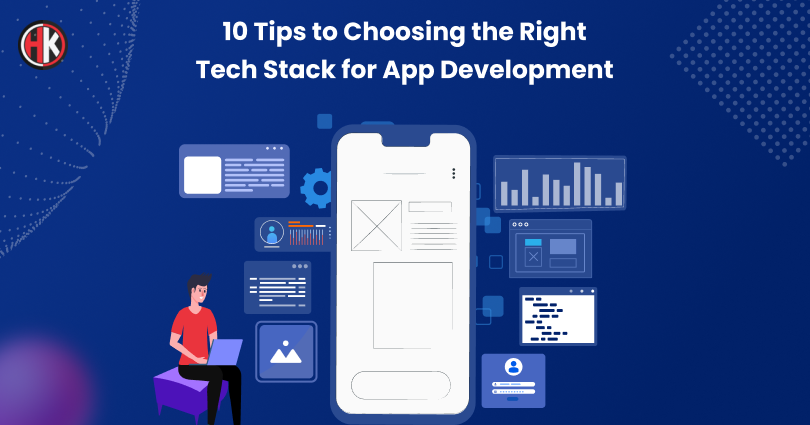
Selecting the appropriate technology stack for web development is a critical step in the project lifecycle. It forms the foundation for achieving your objectives, enhancing performance, and improving developer productivity. The right tech stack guarantees high-quality applications that meet customer expectations.
Choosing the right tech stack that aligns with your app requirements beforehand can prevent numerous issues. It can save you a significant amount of time and budget by avoiding any issue at the time of app development
Deciding on the best technology for a web project can be challenging when you do not belong to an IT field. It requires a deep understanding of the project requirements, extensive experience in multiple programming languages, and knowledge of project management principles.
So, In this article, we will share ten tips to help you choose the right technology stack for your application development. But before moving these steps let’s understand what a technology stack is.
Table of Contents
What is a Technology stack?
The process of developing websites or web applications often involves working with multiple technologies. As a result, the term “technology stack for web development” has emerged to encompass this diversity. When working with a dedicated development team to build a software application, it’s important to understand the concept of a technology stack.
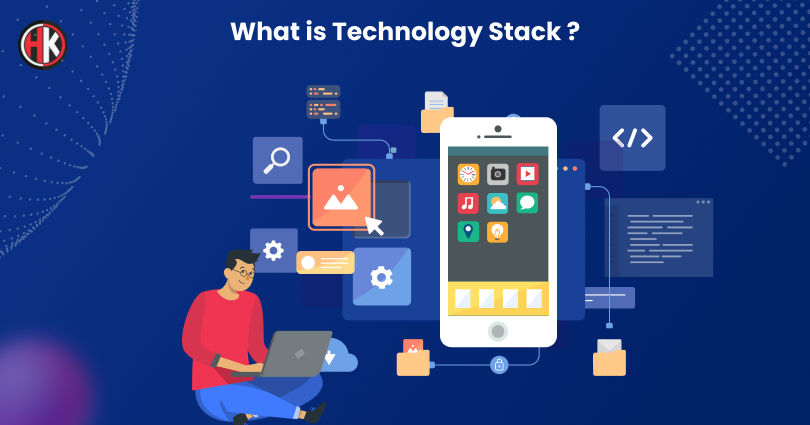
A technology stack is a collection of the components used to build an application, including tools, programming languages, frameworks, libraries, and more. It is important to work with your remote developers to carefully choose the right technology stack that will best meet your project’s requirements.
The technology stack includes both frontend and backend components that work together to ensure the application functions properly.
By selecting the appropriate technology stack, you can ensure the development of a high-quality application that meets your specific needs. You should communicate your project requirements clearly to the developer, so they can recommend the appropriate technology stack.
The right technology stack will ensure the development of functional applications and make it easier to maintain and update in the future. Therefore it is essential to work closely with the developer to choose the best technology stack for your project.
What is Front-end Stack Stack?
The collection of technologies and tools used by front-end developers to create the client side of a web application or website is known as the front-end tech stack. The front-end tech stack is responsible for creating the interface that users see and interact with an application.
What is a Back-end technology stack?
The back-end technology stack is a collection of programming languages, frameworks, and databases utilized by hiring back-end developers to create the server side of web or mobile applications.
It is responsible for server-side operations such as managing databases, processing and storing web data, handling server requests, and communicating with the front end of an application.
You can also Read:-PHP vs Node Js: Which Backend is Better For Your Business?
Most Popular Tech Stack Used For App Development
When it comes to app development, a tech stack is a combination of front-end and back-end technologies is used to create a complete solution.
For front-end development, some of the most popular technology include Nextjs, Angular or Vue.js, all of which are front-end JavaScript-based frameworks that allow developers to create interactive and dynamic user interfaces.

On the other hand, for back-end development, popular technology includes Laravel and Nodejs or Django, which all provide efficient and scalable solutions for server-side programming. The choice of tech stack will depend on factors such as the project requirements, team expertise, and scalability needs.
Ruby on Rails Stack
The Ruby on Rails stack is a collection of technologies that are employed to develop web applications using the Ruby programming language. Among them are the Rails framework for web applications, database management programs, testing frameworks, and deployment tools.
Mean Stack
The MEAN Stack is a complete set of JavaScript technologies that can be used to develop web applications. It comprises MongoDB, Express.js, Angular, and Node.js and is known for its ability to create web applications that are robust, scalable, and fast.
Lamp Stack
The LAMP Stack is a widely used open-source technology stack that allows the development of dynamic and interactive web applications. It includes Linux, Apache, MySQL, and PHP, and is known for its ability to create powerful and flexible web applications.
Dot Net Stack
The .NET Stack is a technology stack developed by Microsoft that is used to build web applications and enterprise-level software. It includes ASP.NET, C#, and SQL Server, and is known for its ability to create robust and scalable software solutions.
Mern Stack
The MERN stack is a combination of tools utilized in creating web applications. It comprises MongoDB (a NoSQL database), Express.js (a back-end web framework), React.js (a front-end JavaScript library), and Node.js (a JavaScript runtime environment). Its purpose is to facilitate the development of full-stack web applications using JavaScript techs for developers.
Read More:- Tips to Hire Mean Stack Developers in the USA for Your Project
10 Pro Tips To Choose The Best Tech Stack For App Development
Let’s explore the key elements in more detail so you can select the best tech stack for app development.

1. Compatibility
It is essential to choose a tech stack that is well-suited for the platforms you want to target, such as iOS, Android, or hybrid. Compatibility is a critical factor that you should consider when selecting a tech stack for developing an app.
Example:- If you plan to develop an app for iOS, you may consider using Swift or Objective-C as your programming language and XCode as your IDE. On the other hand, if you plan to target Android, you may consider using Java or Kotlin as your programming language and Android Studio as your IDE.
Choosing a tech stack that is compatible with your target platform can help ensure that your app functions smoothly and provides a good user experience.
2. Speed and Functionality
When selecting a tech stack for your project, it is important to prioritize the speed and functionality of the developed web application. Choose technological solutions that can ensure compliance with these indicators at the required levels.
This will help to ensure that your web resource is fast and functional, providing a positive user experience and meeting the requirements of your project.
Example:- To ensure a fast and functional e-commerce website, a tech stack that includes React or Angular for the front end and Node.js or Django for the back end can be chosen. These technologies enable responsive user interfaces and efficient server-side processing, ensuring a positive user experience.
3. Size, Type, and Complexity
When selecting a tech stack, consider the size, type, and complexity of your project. A large project will require a more complex tech stack with a range of necessary tools. Decide whether to use ready-made solutions or custom app development to make the most of the programming language’s capabilities.
Careful consideration of these factors will help you choose the most appropriate tech stack for your project.
Example:- The transportation management system for a logistics company may require a complex tech stack with programming languages such as Java or Python, frameworks like Spring or Django, and databases like PostgreSQL or Oracle, along with ready-made solutions like mapping and tracking APIs.
4. Productivity and functionality
The choice of a tech stack for your project should be based on the expected load, productivity, and functionality of the system. Evaluating the capability of different technologies to meet requirements such as load time and fault tolerance is crucial for stable and trouble-free operation.
Choose a tech stack that can meet the demands of your project and ensure reliable and efficient performance.
Example:- To ensure high productivity and functionality of building social media apps , a tech stack comprising JavaScript or PHP programming languages, React or Laravel frameworks, and MongoDB or MySQL databases is necessary. .
Additionally, cloud-based hosting and content delivery networks can be integrated to improve the platform’s performance.
5. Third-Party Tools
When selecting a tech stack, it is important to assess the availability of third-party libraries and tools. These resources can facilitate and accelerate development processes. Therefore, it is crucial to ensure that the tech stack you choose provides a diverse range of third-party libraries and tools that can aid in the development of your project.
Example:- React Native offers third-party libraries and tools like React Navigation, Redux, and Axios, which accelerate app development and improve its quality. Choosing a tech stack with such resources can ensure user satisfaction
6. Scalability
When choosing a tech stack, it is important to assess its scalability to ensure that it can handle future growth, , managed traffic, and larger data volumes. Opting for a tech stack that can scale with your needs can save you from having to undertake a complete overhaul later on.
Example:- For building mobile apps, choose a tech stack with Swift or Kotlin programming languages, React Native or Flutter frameworks, and Firebase or PostgreSQL databases for scalability. Ready-made solutions like push notifications and analytics tools can be added.
7. Flexibility
Consider the flexibility of the tech stack you choose for your project. Ensure that the solution is flexible enough to respond to future project challenges. The availability of development tools is also important to ensure that your team can work efficiently and effectively with the chosen tech stack.
Example:- To create a real-time chat app, you can choose a tech stack consisting of flexible programming languages like JavaScript or Python, adaptable frameworks such as Node.js or Flask, and dynamic databases like Redis or Cassandra, which can help you tackle any future project challenges.
8. Security:
When selecting a tech stack, prioritize robust security features to protect user data and prevent hacking. Choose a tech stack that provides secure protocols and encryption methods to ensure the safety of sensitive information.
Example:- Choose a tech stack with Java or C# programming languages when you building health care apps , Spring or .NET frameworks, and Oracle or SQL Server databases for robust security features. Implement secure protocols like HTTPS and encryption methods like AES or RSA to protect sensitive user data.
9. Performance
To ensure optimal performance, choose a tech stack that provides fast load times, low latency, and minimal downtime. It should be capable of handling high traffic volumes on application without compromising performance. Evaluate the performance of the tech stack carefully before making a decision.
Example:- For building an e-learning application, choose a tech stack that offers fast load times, low latency, and minimal downtime, and can handle high traffic volumes without compromising performance. Evaluate performance carefully before making a decision.
10. Testing
Before implementing the tech stack, it’s essential to test it to ensure that it meets your app’s requirements and performs as expected. Conduct thorough testing to identify any issues and make any necessary adjustments before deployment.
Example:- To ensure that your fintech application performs optimally and is secure, it’s crucial to test the chosen tech stack thoroughly. Make sure it meets the required specifications and resolve any issues identified during the testing phase before deploying the application.
Factors To Consider While Choosing The Right Tech Stack
Choosing an app development tech stack depends on internal factors such as project requirements, scalability needs, and developer expertise, as well as external factors like community support, security, and cost. It is essential to consider both internal and external factors to make an informed decision.

1. Project Requirements
When selecting a tech stack, it’s important to take into account your project’s unique requirements, such as its scalability, security, and performance needs.
2. Development Team expertise:
It is important to evaluate the proficiency of your development team in the chosen tech stack to ensure that they possess the necessary skills and experience
3. Cost
Assess the expenses associated with the tech stack, which may include licensing fees, development tools, and the costs of ongoing maintenance
4. Integration
It is important to ascertain whether the tech stack is compatible with other tools and technologies that may be required for your project
5. Future- Proofing
Evaluate if the tech stack can adapt to changing technology and market trends for future-proofing.
6. Time-To-Market
You should evaluate the time required for developing and deploying the application by using the chosen tech stack.
6. User Experience
Make sure that the tech stack has the capability to provide a great user experience and fulfill the user’s expectations.
7. Needs and resource
Your development stack is influenced by the size of your project and the features you have assembled. It’s important to consider your budget as some technologies may require expensive software or license fees.
8. Competitors’ research
Although keeping up with industry trends is important, avoid following your rivals’ lead. Keep in mind that their objectives, spending limits, team dynamics, and needs may differ.
9. Ready-made solution
Using open-source APIs is a cost-effective way to avoid building solutions from scratch. They are customizable, work well with other technologies, and are up-to-date.
10. Cloud Solution
Cloud solutions offer improved reliability and scalability for your software, while also providing security benefits such as firewalls, encryption, and multi-factor authentication.
You can also read:- Node.js vs React.js: Which Technology is Better for Web Development
Conclusion
Selecting a technology stack for app development is a complex process that requires careful consideration of various factors. While there are different approaches to take, planning ahead can save time and money and ensure a timely launch.
Alternatively, you can try to pick the best possible stack for app development. You might also hire a software development company.
Our team at Hackerkernel has extensive expertise in utilizing different technology stacks for a variety of industry projects, making us capable of handling your web development needs. You can rely on our skilled team of experts to transform your ideas, objectives, and business requirements into reality.
FAQ (Frequently Asked Questions)
1. What are the best tech stacks for mobile apps in 2023?
Choosing a tech stack that meets the specific requirements of a mobile app is crucial. Popular tech stacks include React Native, Kotlin, Swift, and Xamarin. Weighing the pros and cons and considering factors like performance and maintenance costs is essential
2. How do I choose a tech stack for application development?
To choose a tech stack for application development, you should assess project requirements, consulting, team expertise, scalability, development time, and cost-effectiveness.
3. Why is the tech stack essential for app development?
The tech stack Is a crucial aspect of app development as it encompasses the tools, frameworks, and programming languages used to develop the application. The choice of tech stack can have an impact on the app’s performance, scalability, and functionality, as well as the time and cost required to develop it.
4. What are the Benefits of choosing the right tech stack?
Choosing the right technology stack can enhance app development by improving performance, scalability, and functionality, while decreasing development costs, increasing team productivity, or user experience.
5. What is a tech stack?
The technical stack is the set of tools, frameworks, and programming languages that a web application development team uses to create it. Client-side (front-end) and server-side (back-end) are its two main parts.

Husain Saify
Founder & CEO
Hey, I am Husain Saify, the Founder and CEO of Hackerkernel. I like to share some valuable information about Industry. You can also Reach Out to me On Linkedin.hello@hackerkernel.com

